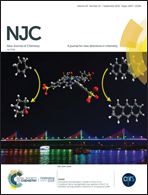Electrochemical determination of methyl parathion based on pillar[5]arene@AuNPs@reduced graphene oxide hybrid nanomaterials
Abstract
The detection of pesticides has become a very important and critical research area because of the rapid development of agriculture and strict environmental protection regulations. In this paper, a fast and sensitive non-enzymatic electrochemical sensor for methyl parathion (MP) on a glassy carbon electrode (GCE) modified with hydroxylatopillar[5]arene@gold nanoparticles and electrochemical reduced graphene oxide (HCP5@AuNPs–ERGO) hybrid nanomaterials was proposed. The properties of the modified electrode were characterized by cyclic voltammetry (CV), differential pulse voltammetry (DPV) and electrochemical impedance spectroscopy (EIS). The experimental parameters such as preconcentration time, preconcentration potential and pH value were optimized. It was found that the improved electrode showed a high detection sensitivity to MP, with a detection range of 0.005 μM to 30 μM and a detection limit (LOD) of 0.001 μM, and other interfering substances had no effect on the detection of MP. In addition, the modified electrode is also used for the detection of MP in actual water samples, showing an efficient sensing capability. The results show that the electrochemical sensor provides a new idea for the trace analysis of MP in agricultural and environmental samples.
![Graphical abstract: Electrochemical determination of methyl parathion based on pillar[5]arene@AuNPs@reduced graphene oxide hybrid nanomaterials](/en/Image/Get?imageInfo.ImageType=GA&imageInfo.ImageIdentifier.ManuscriptID=C9NJ02901J&imageInfo.ImageIdentifier.Year=2019)


 Please wait while we load your content...
Please wait while we load your content...